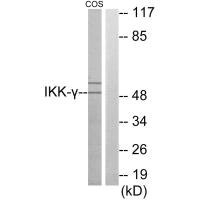
Western blot analysis of extracts from COS-7 cells, using IKK-gamma antibody.
IKBKG Antibody
CSB-PA055629
ApplicationsWestern Blot, ELISA
Product group Antibodies
ReactivityHuman
TargetIKBKG
Overview
- SupplierCusabio
- Product NameIKBKG Antibody
- Delivery Days Customer20
- ApplicationsWestern Blot, ELISA
- CertificationResearch Use Only
- ClonalityPolyclonal
- ConjugateUnconjugated
- Gene ID8517
- Target nameIKBKG
- Target descriptioninhibitor of nuclear factor kappa B kinase regulatory subunit gamma
- Target synonyms14.7K (adenovirus E3 protein) interacting protein 3; AMCBX1; EDAID1; FIP3; FIP-3; Fip3p; I-kappa-B kinase subunit gamma; ikB kinase subunit gamma; ikB kinase-associated protein 1; IKKAP1; IKKG; IKK-gamma; IMD33; incontinentia pigmenti; inhibitor of kappa light polypeptide gene enhancer in B-cells, kinase gamma; inhibitor of nuclear factor kappa B kinase subunit gamma; IP; IP1; IP2; IPD2; NEMO; NF-kappa-B essential modifier; NF-kappa-B essential modulator; ZC2HC9
- HostRabbit
- IsotypeIgG
- Protein IDQ9Y6K9
- Protein NameNF-kappa-B essential modulator
- Scientific DescriptionRegulatory subunit of the IKK core complex which phosphorylates inhibitors of NF-kappa-B thus leading to the dissociation of the inhibitor/NF-kappa-B complex and ultimately the degradation of the inhibitor. Its binding to scaffolding polyubiquitin seems to play a role in IKK activation by multiple signaling receptor pathways. However, the specific type of polyubiquitin recognized upon cell stimulation (either Lys-63-linked or linear polyubiquitin) and its functional importance is reported conflictingly. Also considered to be a mediator for TAX activation of NF-kappa-B. Could be implicated in NF-kappa-B-mediated protection from cytokine toxicity. Essential for viral activation of IRF3. Involved in TLR3- and IFIH1-mediated antiviral innate response; this function requires Lys-27-linked polyubiquitination. Xiao G., Oncogene 19:5198-5203(2000). Hong X., FEBS Lett. 499:133-136(2001). Wu R.-C., Mol. Cell. Biol. 22:3549-3561(2002).
- ReactivityHuman
- Storage Instruction-20°C or -80°C
- UNSPSC12352203
